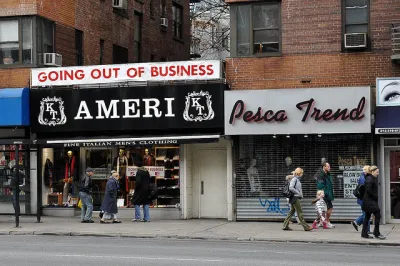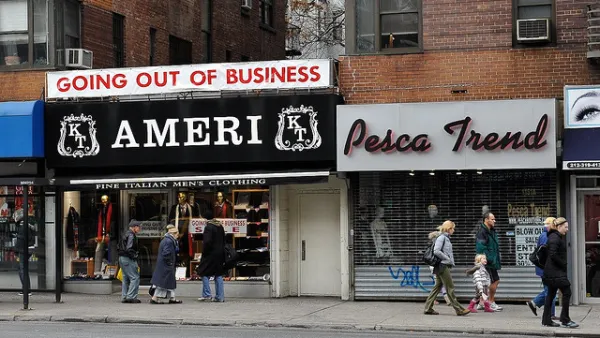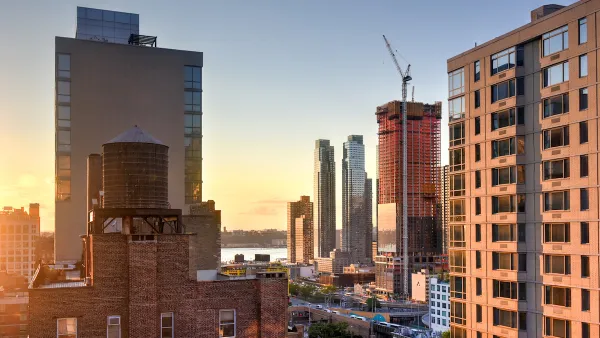Why are so many shops closing in New York's richest and best-known neighborhoods?

Tim Wu reports on a counter-intuitive "surge of closings and shuttered shops" in New York's West Village and other affluent neighborhoods with unparalleled demand.
"Abandoned storefronts have long been a hallmark of economic depression and high crime rates, but the West Village doesn’t have either of those. Instead, what it has are extremely high commercial rents, which cause an effect that is not dissimilar. 'High-rent blight' happens when rising property values, usually understood as a sign of prosperity, start to inflict damage on the city economics that Jane Jacobs wrote about."
Wu goes on to list some of the closings that have occurred in the neighborhood—and the rising rents that preceded the loss of the businesses. As for why the vacant units don't immediately get filled by new tenants, Wu speculates that it could be tax benefits, but it could also be a form speculation:
"[Landlords will] trade a short-term loss for the chance eventually to land a much richer tenant, like a bank branch or national retail chain, which might pay a different magnitude of rent. If you’re a landlord, why would you keep renting to a local café or restaurant at five thousand or ten thousand dollars a month when you might get twenty thousand or even forty thousand dollars a month from Chase?"
Wu allows that leaving the blight of vacant retail properties threatens to destroy what makes such neighborhoods so desirable in the first place.
As for what can be done to imitigate the problem, Wu mentions two regulatory proposals with support from local advocates. One would "limit rent spikes by making commercial-lease-renewal disputes subject to mandatory mediation and arbitration, like some baseball salaries." The other would fine landlords for leaving storefronts empty. Wu also mentions the possibility of allowing interim uses in the storefronts.
FULL STORY: Why Are There So Many Shuttered Storefronts in the West Village?

National Parks Layoffs Will Cause Communities to Lose Billions
Thousands of essential park workers were laid off this week, just before the busy spring break season.

Retro-silient?: America’s First “Eco-burb,” The Woodlands Turns 50
A master-planned community north of Houston offers lessons on green infrastructure and resilient design, but falls short of its founder’s lofty affordability and walkability goals.

Delivering for America Plan Will Downgrade Mail Service in at Least 49.5 Percent of Zip Codes
Republican and Democrat lawmakers criticize the plan for its disproportionate negative impact on rural communities.

Test News Post 1
This is a summary

Test News Headline 46
Test for the image on the front page.

Balancing Bombs and Butterflies: How the National Guard Protects a Rare Species
The National Guard at Fort Indiantown Gap uses GIS technology and land management strategies to balance military training with conservation efforts, ensuring the survival of the rare eastern regal fritillary butterfly.
Urban Design for Planners 1: Software Tools
This six-course series explores essential urban design concepts using open source software and equips planners with the tools they need to participate fully in the urban design process.
Planning for Universal Design
Learn the tools for implementing Universal Design in planning regulations.
EMC Planning Group, Inc.
Planetizen
Planetizen
Mpact (formerly Rail~Volution)
Great Falls Development Authority, Inc.
HUDs Office of Policy Development and Research
NYU Wagner Graduate School of Public Service





























